You can help expand this article with text translated from the corresponding article in Russian. (October 2017)Click [show] for important translation instructions.
|

Paraguay gained independence from Spain in 1811.
You can help expand this article with text translated from the corresponding article in Russian. (October 2017)Click [show] for important translation instructions.
|

Paraguay gained independence from Spain in 1811.
Paraguay operated an internal postal service from 1769 to 1811. Mail travelled from Buenos Aires via Santa Fe and Corrientes to Candelaria and Asuncion. [1]

The republic of Paraguay issued its first stamps (1, 2, and 3 Reales) on 1 August 1870, [2] featuring a standing lion raising a republican hat, lithographed by R. Lange (Buenos Aires). [3]

José Gervasio Artigas Arnal was a soldier and statesman who is regarded as a national hero in Uruguay and the father of Uruguayan nationhood.

The Argentine War of Independence was a secessionist civil war fought from 1810 to 1818 by Argentine patriotic forces under Manuel Belgrano, Juan José Castelli, Martin Miguel de Guemes and José de San Martín against royalist forces loyal to the Spanish crown. On July 9, 1816, an assembly met in San Miguel de Tucumán, declaring independence with provisions for a national constitution.
The 1921 South American Championship was the fifth continental championship for nations in South America. It was held in Buenos Aires, Argentina, from 2 to 30 October 1921.

The Viceroyalty of the Río de la Plata meaning "River of the Silver", also called "Viceroyalty of the River Plate" in some scholarly writings, in southern South America, was the last to be organized and also the shortest-lived of the Viceroyalties of the Spanish Empire in the Americas. The name "Provincias del Río de la Plata" was formally adopted in 1810 during the Cortes of Cádiz to designate the Viceroyalty of the Río de la Plata.

The twelfth edition of the South American Championship was held in Buenos Aires, Argentina from 1 to 17 November 1929. The 1928 edition was postponed due to the participation of Chile, Uruguay and Argentina in the 1928 Summer Olympics held in Amsterdam, Netherlands, where Uruguay and Argentina won gold and silver respectively.
Junta Grande, or Junta Provisional Gubernativa de Buenos Aires, is the most common name for the executive government of the United Provinces of the Río de la Plata, that followed the incorporation of provincial representatives into the Primera Junta.
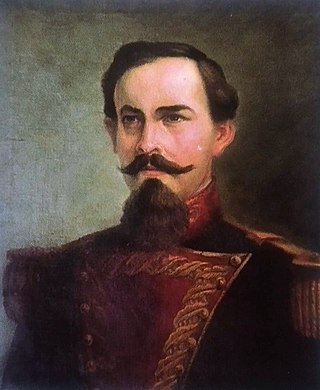
Fulgencio Yegros y Franco de Torres was Paraguayan soldier and first head of state of independent Paraguay. The town of Yegros is named in his honor.

The nineteenth edition of the South American Championship in football was held in Buenos Aires, Argentina from 12 January to 10 February. This tournament, an extra edition with no trophy handed to the winners, is considered official by CONMEBOL.

Pedro Juan Caballero was a leading figure of Paraguayan independence. He was born in Tobatí, a town located Cordillera Department of Paraguay which was then part of the Spanish Viceroyalty of the Río de la Plata. He was one of the major leaders of the Revolution of May 14, 1811, despite being six years younger than the leading figure of Independence period Fulgencio Yegros and 20 years younger than the future dictator of Paraguay José Gaspar Rodríguez de Francia. In 1820 he was accused of being involved in the conspiracy against Francia, and committed suicide in his cell on July 13, 1821. The Paraguayan city of Pedro Juan Caballero is named after him.

Foreign relations between the Argentine Republic and the Republic of Paraguay, have existed for more than two centuries. Diplomatic relations between those two neighbors were established in 1811 with the signing of an agreement on Friendship, Assistance and Trade. Both countries were at war between 1864 and 1870, but have not fought one another other since.
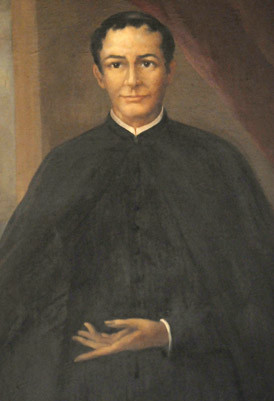
Francisco Javier Bogarín was a Catholic priest and teacher who actively participated in the process of independence of Paraguay. Born in Carapeguá, Paraguarí Department, 66 kilometers from Asunción, in 1763. For a couple of months in 1811 he was a member of the five-man governing junta of Paraguay.
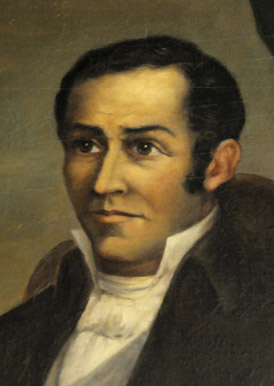
Fernando de la Mora was one of the founding fathers of Paraguay, and was an early leader of the country between 1811 and 1813, but soon lost his power and died imprisoned. The Paraguayan city Fernando de la Mora is named in his honor.
The Battle of Tacuarí was a battle in Southern Paraguay between revolutionary forces under the command of General Manuel Belgrano, member of the Primera Junta government of Argentina, and Paraguayan troops under colonel Manuel Atanasio Cabañas, at the time at the service of the royalists.

Paraguay–Spain relations are the current and historical relations between Paraguay and Spain. Both nations are members of the Association of Spanish Language Academies and the Organization of Ibero-American States.
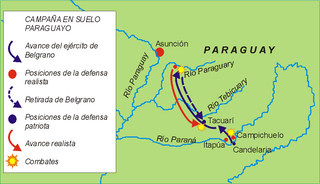
The battle of Paraguarí took place on January 19, 1811, in Paraguarí, Paraguay, between the patriot army led by Manuel Belgrano and the Royalist army located in Paraguay led by Bernardo de Velasco. The battle would end with a Paraguayan victory; but it boosted confidence in the local population to declare themselves independent from both Buenos Aires patriots and royalists months later.
Events in the year 1866 in Argentina.
Pamphalea is a genus of flowering plants in the family Asteraceae. The genus was first described by Lagasca in 1811, who spelled it Panphalea. de Candolle emended the spelling to Pamphalea in 1812, and that spelling has been generally accepted.

Tomás Onésimo Canavery (1839–1913) was an Argentine Catholic priest and military chaplain, who served under the command of Bartolomé Mitre during the War of the Triple Alliance. He participated in most of the military actions against the Paraguayan forces, being promoted to lieutenant colonel in the same battlefield by order of General Juan Andrés Gelly y Obes.

The independence of Paraguayde facto started on 14 May 1811 after the Revolution of May 14 when a local ruling junta was created. In early 1811 Paraguayan forces had repeatedly defeated the Argentine army which considered Paraguay to be a break-away province. On 12 October 1813 the Paraguayan Republic was proclaimed. Officially, independence was proclaimed only on 25 November 1842. Paraguayan independence was assured only after the Paraguayan War, when the Empire of Brazil resisted Argentine offers to divide and annex the country.
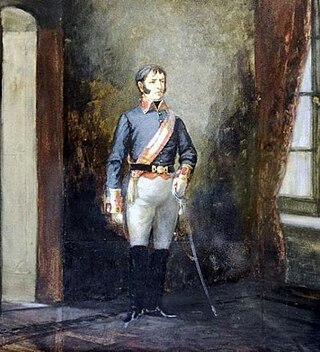
Bernardo Luis de Velasco y Huidobro was a figure in the Spanish American wars of independence, the last Spanish governor of the Intendency of Paraguay and a commander of royalist military forces in the war. He was deposed by the congress celebrated in Asunción on 17 June 1811. He was born in Villadiego, Burgos, Spain.